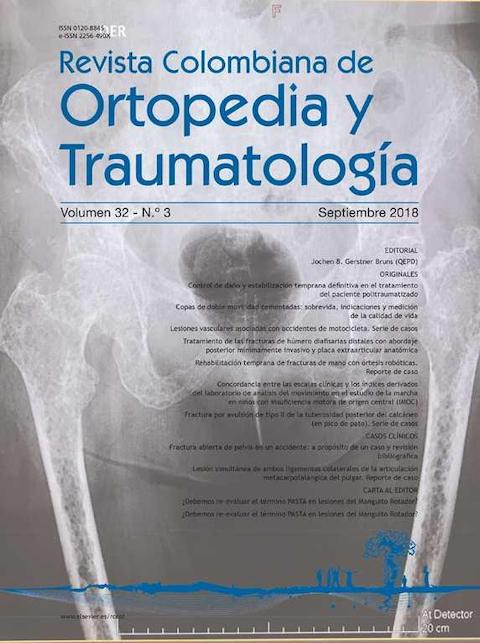Concordance between clinical scales and indexes derived from gait analysis studies of in children with cerebral palsy
DOI:
https://doi.org/10.1016/j.rccot.2017.11.003Keywords:
cerebral palsy, classifications, GDI, GPS, FMS, FAQ, GMFCS, gaitAbstract
Background: Cerebral Palsy (CP) in children can be classified in terms of function according to several scales, some clinics such as GMFCS (Gross Motor Function Classification System), FMS (functional mobility Scale), FAQ (Gillette Functional Assessment Walking Scale); and others carried out in gait analysis such as the GDI (Gait Deviation Index), GPS (Gait Profile Score). The aim of this study was to determine the concordance between the clinical and gait analysis scales.
Methods: 104 children between five and sixteen years old diagnosed with Cerebral palsy were included. A cross sectional and retrospective study analyzed data from three clinical scales of functional mobility and a 3D gait analysis were carried out in gait analysis laboratory, using a SMART-D/BTS equipment and two strength platforms.
Results: Regarding the concordance between the scales evaluated, we found that the highest value of kappa (0416), occurred when confronting FAQ and FMS at 50 m, showing a moderate concordance. The remaining values of Kappa when comparing the different scales were smaller than 0.4. While when comparing the scales according to the percentage of agreement we found that the highest percentage was 62.50% when comparing FMS against GPS, followed by 60.50% when comparing FAQ against FMS.
Discussion: Not always an acceptable correlation means a high agreement to classify patients at the same level of involvement. The low correlation between most of the scales indicates that the gait analysis in children with Cerebral Palsy should be performed in a complementary manner, performing an assessment with clinical scales, quality of life, and functionality and with instrumented motion analysis.
Evidence level. II.
Downloads
References
Westberry D, Davids J. Cerebral palsy. En: Song K, editor. Orthopaedic Knowledge Update (OKU) Pediatrics 4. 4.a ed. North River Road Rosemont: American Academy of Orthopaedic Surgeons; 2011. p. 95-104.
Bax M, Goldstein M, Rosenbaum P, Leviton A, Paneth N, Dan B, et al. Proposed definition and classification of cerebral palsy. Dev Med Child Neurol. 2005;47:571-6. https://doi.org/10.1017/S001216220500112X
Blair E. Epidemiology of the cerebral palsies. Orthop Clin North Am. 2010;41:441-55. https://doi.org/10.1016/j.ocl.2010.06.004
Rethlefsen SA, Ryan DD, Kay RM. Classification systems in cerebral palsy. Orthop Clin North Am. 2010;41:457-67. https://doi.org/10.1016/j.ocl.2010.06.005
Lorente Hurtado I. La parálisis cerebral. Actualización del concepto, diagnóstico y tratamiento. Pediatría Integr. 2007;11:687-98.
Graham HK, Harvey A, Rodda J, Nattrass GR, Pirpiris M. The Functional Mobility Scale (FMS). J Pediatr Orthop. 2004;24:514-20. https://doi.org/10.1097/01241398-200409000-00011
Graham HK. Classifying Cerebral Palsy. J Pediatr Orthop. 2005;25:128-9. https://doi.org/10.1097/00004694-200501000-00026
Cimolin V, Galli M. Summary measures for clinical gait analysis: A literature review. Gait Posture. 2014;39:1005-10. https://doi.org/10.1016/j.gaitpost.2014.02.001
Schwartz MH, Rozumalski A. The gait deviation index: A new comprehensive index of gait pathology. Gait Posture. 2008;28:351-7. https://doi.org/10.1016/j.gaitpost.2008.05.001
Rasmussen HM, Nielsen DB, Pedersen NW, Overgaard S, Holsgaard-Larsen A. Gait Deviation Index, Gait Profile Score and Gait Variable Score in children with spastic cerebral palsy: Intrarater reliability and agreement across two repeated sessions. Gait Posture. 2015;42:133-7. https://doi.org/10.1016/j.gaitpost.2015.04.019
Hillman SJ, Hazlewood ME, Schwartz MH, van der Linden ML, Robb JE. Correlation of the Edinburgh Gait Score With the Gillette Gait Index, the Gillette Functional Assessment Questionnaire, and Dimensionless Speed. J Pediatr Orthop. 2007;27:7-11. https://doi.org/10.1097/BPO.0b013e31802b7104
Robinson LW, Clement N, Fullarton M, Richardson A, Herman J, Henderson G, et al. The relationship between the Edinburgh Visual Gait Score, the Gait Profile Score and GMFCS levels I-III. Gait Posture. 2015;41:741-3. https://doi.org/10.1016/j.gaitpost.2015.01.022
Palisano RJ, Rosenbaum P, Bartlett D, Livingston MH. Content validity of the expanded and revised Gross Motor Function Classification System. Dev Med Child Neurol. 2008;50:744-50. https://doi.org/10.1111/j.1469-8749.2008.03089.x
Tugui RD, Antonescu D. Cerebral Palsy Gait, Clinical Importance. Maedica (Buchar). 2013;8:388-93.
Van Den Berg-Emons RJ, apos L, Ortye AA, Buffart LM, Nieuwenhuijsen C, Nooijen CF, Bergen MP, et al. Validation of the physical activity scale for individuals with physical disabilities. Arch Phys Med Rehabil. 2011;92:923-8. https://doi.org/10.1016/j.apmr.2010.12.006
Gordon G, Stout J, Bagley A, Bevans K, Novacheck T, Tucker C. Gillette Functional Assessment Questionnaire 22-item skill set: factor and Rasch analyses. Dev Med Child Neurol. 2011;53:250-5. https://doi.org/10.1111/j.1469-8749.2010.03832.x
Baker R, McGinley JL, Schwartz MH, Beynon S, Rozumalski A, Graham HK, et al. The Gait Profile Score and Movement Analysis Profile. Gait & Posture. 2009;30:265-9. https://doi.org/10.1016/j.gaitpost.2009.05.020





